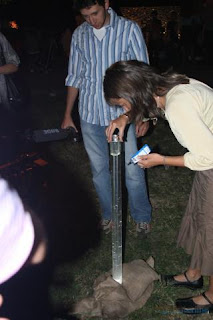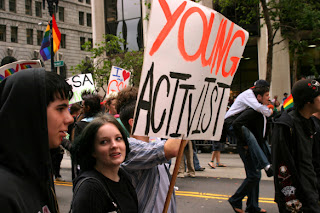
One thing I have to remind myself is that "public art" has inherently, the word "public" in it.
This has been really driven home during the installation of the beacons during the
HighWaterLine project. I have placed the beacons in 5 city parks (sorry that I never got to redo Canarsie) spanning the coast of
Brooklyn and
Lower Manhattan. Most of the installations were fairly peaceful and a nice opportunity to talk to people about New York City and climate change.
Every one of the installations involved at least one act of "public interaction." At the very first installation in Corlear's Hook Park, a gentleman was looking at the beacon, then knelt down, pulled the beacon out of the ground (it is staked on 4 corners) and removed the flashlight in the base. I was standing about 60 feet away and called out, "would you mind putting that back?" he did so, and quietly tried to restake the beacon, all without saying a word.
When I installed in
Battery Park a few people would walk up, and without even pausing to look closely at the beacon, grabbed it and roughly shook it back and forth. Much like you would a snowglobe. I have had a lot of opportunity to ponder this, and cannot for the life of me understand what is the point of this activity. To me it is the equivalent of walking up to a friend, seeing that they are wearing an interesting shirt and then grabbing it and pulling them roughly about as if to see if the shirt is going to fall apart in my hands.

This activity, let's call it snowglobing (sounds vaguely rude), has happened at least once in every installation of the beacons, but the real test was the weekend long installation that just occurred as part of the
Dumbo Art Center's
Art Under the Bridge Festival. This massive art festival consists of installations, performances and projections and general insanity around
Dumbo. There are probably around 20-30,000 people who pass through the area over the weekend. I installed the beacons on Friday afternoon and took them out on Sunday evening. Over the weekend the beacons were more than snowglobed, they were knocked down, moved, emptied, turned over, altered and pieces stolen. I don't even want to consider what might have happened that moved one beacon (and the wet, 20 pound bags of sand) about 10 feet from its original location.
Every time I visited they were in disarray. I was sometimes shocked, but mostly amused with a hint of annoyance. I calmly went about resurrecting them, often with the assistance of some kind onlookers. I should make a point that most people are very respectful of the work and treat it carefully, enjoying it in a non-threatening way and ensuring the work is left in tact for other to also enjoy. This was not the case however when a friend and fellow public artist went to visit the work in
Brooklyn Bridge Park during the festival. She was so sickened by the obnoxious treatment (including a parent who watched their child knock it about, eventually toppling it) that she had to leave immediately.
So, not to disparage what is obviously a strong and fairly common urge, but if there is anyone out there who has participated in a snowglobing type of activity, we on the art making side of the fence would love to know more about why this is done...





